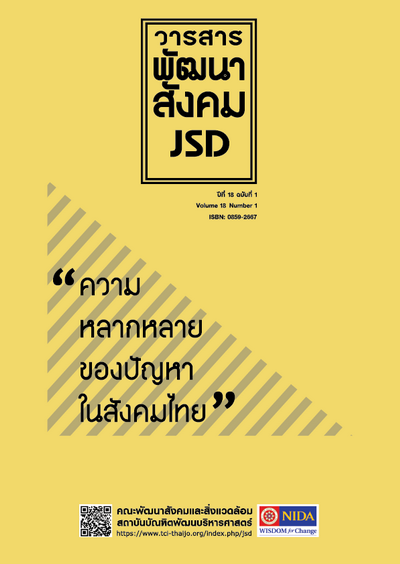พลวัตการจัดการทุนทางสังคมในชุมชนต่างศาสนา: กรณีศึกษาชุมชนตำบลทรายขาว อำเภอโคกโพธิ์ จังหวัดปัตตานี The Dynamics of Social Capital Management in Multi-Religious Societies: A Case Study of the Tumbon Tsaikhao Community in Amphor Kokpoe, Pattani Province,
Main Article Content
Abstract
การวิจัยนี้มีวัตถุประสงค์เพื่อศึกษาลักษณะ และองค์ประกอบเชิงเงื่อนไขของทุนทางสังคมที่ทำให้ชุมชนต่างศาสนาอยู่ร่วมกันอย่างสันติสุข และเพื่อศึกษาพลวัตการจัดการทุนทางสังคมและผลที่เกิดขึ้น โดยใช้วิธีการเชิงคุณภาพ ได้แก่ การสัมภาษณ์เชิงลึก สนทนากลุ่ม สังเกตทั้งแบบมีส่วนร่วมและไม่มีส่วนร่วม ผลการศึกษาพบว่า (1) ลักษณะทุนทางสังคม คือ การยอมรับและไว้วางใจผู้ที่นับถือศาสนาอื่น มีการแลกเปลี่ยนต่างตอบแทนที่สืบทอดกันมา และมีการรวมกลุ่มเพื่อการพัฒนาชุมชน องค์ประกอบเชิงเงื่อนไขของทุนทางสังคม ได้แก่ สภาพภูมิประเทศที่บีบบังคับให้ต้องพึ่งพาอาศัยกัน เกียรติยศชื่อเสียงของชุมชนท้องถิ่นที่โดดเด่น วาทกรรม 'คนทรายขาว' ภาษา ความเชื่อต่อสิ่งศักดิ์สิทธิ์ ขนาดเครือข่าย และเครือญาติ (2) พลวัตการจัดการทุนทางสังคมและผลที่เกิดขึ้น คือ การเสริมสร้าง การดำรงรักษา และการพัฒนาหรือปรับปรุงทุนทางสังคม ซึ่งผู้นำศาสนาพุทธมีบทบาทมากที่สุดในการเสริมสร้างทุนทางสังคมระหว่างปี พ.ศ. 2504-2539 โดยใช้ประโยชน์จากขนาดเครือข่าย และความเป็นเครือญาติในการหลอมรวมจิตใจสมาชิกชุมชน ส่วนหน่วยงานภาครัฐมีบทบาทในการเสริมสร้างและดำรงรักษาทุนทางสังคมอย่างชัดเจนตั้งแต่ปี พ.ศ. 2530 เป็นต้นมา ด้วยการสนับสนุนงบประมาณในการจัดตั้งกลุ่มต่าง ๆ เพื่อการพัฒนาชุมชน สำหรับผู้นำชุมชนมีบทบาทในการดำรงรักษาทุนทางสังคมด้วยการสร้างบรรทัดฐานให้ผู้ที่นับถือศาสนาต่างกันผลัดกันดำรงตำแหน่งกำนัน และสมาชิกชุมชนมีบทบาทในการปรับปรุงทุนทางสังคมโดยการเปลี่ยนแปลงสัญลักษณ์ที่แสดงความเป็นเครือญาติให้สอดคล้องกับพลวัตของชุมชนแห่งนี้ ผลการจัดการทุนทางสังคมดังกล่าวทำให้ผู้คนต่างศาสนาในชุมชนแห่งนี้ยังคงมีความสามัคคี และร่วมมือกันในการพัฒนาชุมชนมาโดยตลอด
The objectives of this research were to study the characteristics and conditional factors of social capital that contribute to harmony in multi-religious societies and to investigate the dynamics and consequences of social capital management. The qualitative research methods: in-depth interviews, focus group discussion, participant observation and non-participation observation were mainly employed in this research. The results showed that 1) the characteristics of social capital included acceptance and trust in people of other religions, handed-down reciprocity, and community development gathering. The conditional factors of social capital were topography that forced people to be interdependent, community reputation, community discourse (“Kon Tsaikhao”), common language, sacred beliefs, network size, and kinship; 2) the dynamics and consequences of social capital management were social capital creation, maintenance, and development. The Buddhist religious leaders played dominant roles in social capital creation during 1961-1996 by using their large network and ties of kinship to connect the community members with each other. The governmental organizations started to take solid action on social capital creation and maintenance in 1987 and have provided financial support for community development gatherings ever since. Considering the role of local leaders in social capital maintenance, they established the community norm that the position of village headman should be rotated among those who follow different religions. In terms of social capital development, the local leaders change a symbol of kinship in accordance with the dynamics of this community. The social capital management made people of different religions in this community continue to live in unity and always collaborate with each other to develop their own community.

